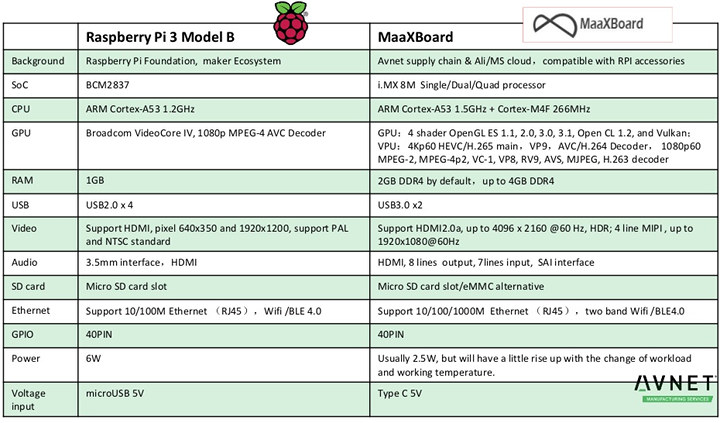levi
Still fresh, damnit!
That depends on how you define 'pyra-like'. Two full sized SD card slots? Highly unlikely. Game controls and a keyboard? Uncommon. 4G comms included? Still uncommon in the 'powered by a Pi' space.
Especially when you can cherry pick a specific set of conditions for which the 'new' has a special trick to be faster - and not give any detail as to what was actually running for this, likely highly selective to their favor, "same workloads" 'test'.
The iMX8QM/P (A72+A53+GC7000) should be released pretty soon. Checking digikey, it looks like the price point for this SOC will be around $120, over double the cost of an iMX8MQ (A53+GC7000Lite). There is a raspberry Pi-esque board using an 8MQ which I may pick up to see how the performance compares to the OMAP5 once most of the urgent repairs are done in our BSP.
http://www.embest-tech.com/prod_view.aspx?TypeId=117&Id=388&Fid=t3:117:3
Support for GL/ES3.1 and apparently actual GL3.0 sounds like a step up to me, but I don't know at what thermal cost that all banks in.

Electrical schematics yes, not sure about PCB layout. Actually he already released them in a previous post, although this may not have any current revisions.Has ED made any indication that he plans to open up the schematics for the CPU board?
Electrical schematics yes
However, I’m assuming a separate kernel, full integration of the new SOC into our kernel would be a little bit of work.
Very happy to hear thatWhat do you percieve as the major hurdles with porting the current Pyra kernel to the iMX8MQ? Having toyed with some kernel and bare-metal code myself I wouldn't be opposed to trying to make time for this if we want to get it off the ground.
If you’re interested in helping out with the OMAP5 BSP also, let me know.
Yes I agree. Designing a new CPU board is a significantly smaller undertaking compared to the previous tasks of CPU board, mainboard, and display board. So I disagree with the 3 year timeline of designing this board. Hardware and basic software support should be doable in under a year. However, I’m assuming a separate kernel, full integration of the new SOC into our kernel would be a little bit of work.
Also the amount of software work changes significantly depending on the hardware chosen. From my experience, working with the iMX8 family is the path of least resistance software wise. I have done board bringup on iMX8MQ based platforms in the past and it has very good support. Many other vendors have proven to have significantly worse software support (poorly written kernel code that needs to be rewritten, etc).
While I tend to agree on many of these points I don't think the lithography means as much as you think it means with regards to performance or even performance per watt. I think my favorite computer history example of this is the pentium vs PowerPC battle in the early 2000s. At this time, the PowerPC cores and the Intel cores were manufactured at the same process, but PowerPC could significantly beat intel at thermals and on raw performance simply because its architecture is more optimized (https://lowendmac.com/1998/powerpc-vs-pentium-ii-escargot/). This may be a contrived example since the architectures are fundamentally quite different, but there still exist these possibilities today. Newer architectural advances can provide these kinds of performance/watt benefits even within the confines of the ARM architecture by doing exactly what you said, creating dedicated hardware inside the processor to handle certain functions. This makes it faster and more power efficient.Whether or not it can be done inside a year or not, there are sunk costs in making the current one work - and then the sunk costs of the environment around it. We as a community need it to be stable on one SoC for some time for it to be what we're after. Trying to pick a new SoC and starting any form of new development prior to shipping the current version is a big mistake. I can hear people thinking: "I've waited three years for this one - it costs a lot - if I just wait one more year I'll have a 'better one'..." That does not encourage the immediate orders and community software development needed for the Pyra to be a success.
Any thoughts to a new SoC needs to start with a lithography process of 20nm or smaller. The OMAP5432 is already on a 28nm process - the same as the ones being presented. A dramatic jump in real/general performance per Watt is only going to be seen with a lithography shrink. Sure, the 'newer' SoCs will have improvements in very specific functions - essentially additional ASICs in the CPU to handle very specific functions faster.
I'm not saying we should never consider a new SoC. I'm saying that it is WAY too early to consider a new SoC. I don't know what is going to be available on the market in two years, but I know that 2 years out is about the right timeframe to be then looking at what is available and on a 14nm or 20nm (at worst) process so that we can get a general increase in perf/Watt and not just chasing the cool new fringe functions strapped onto the latest silicone.
We have not even started to squeeze all of the performance and capabilities out of the current SoC. Why would we need another one already?

